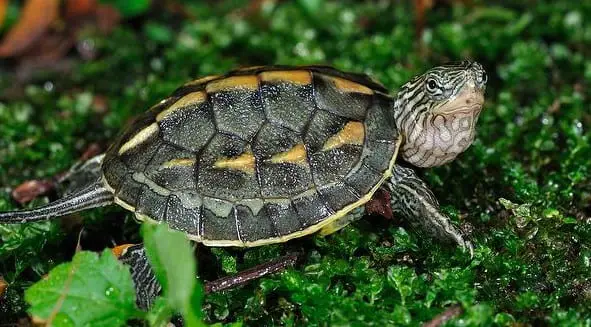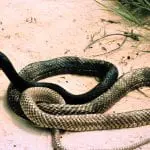Scientific Facts
| Common Name: | Golden Thread Turtle |
| Scientific Name: | Mauremys sinensis |
| Life Span: | 40 to 60 years |
| Size: | 6 to 8 inches for males, 10 to 12 inches for females |
| Habitat: | Creeks, swamps, ponds, lakes, and rivers |
| Country of Origin: | China, Northern Vietnam, Taiwan, and Laos |
Physical Description
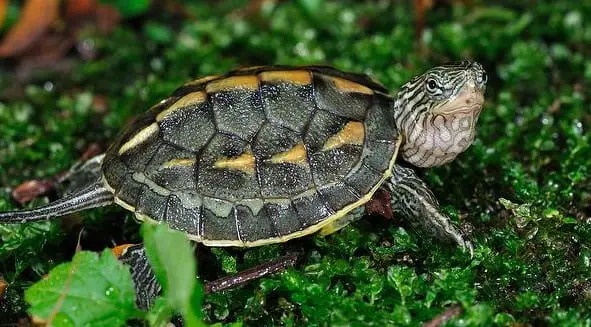
The Golden Thread Turtle, also called the Chinese Stripe-Necked Turtle, are smaller types of turtles that rarely grow more than 10 inches. As the name suggests, these turtles actually have stripes not only on their necks but also on their faces. The stripes start horizontally from their snout or mouth and extend all the way down to their shoulders.
Meanwhile, the forelegs of the Golden Threat Turtle also have stripes that start from the shoulder and then extend vertically all the way down to half of their legs where the knees are. These turtles also have unusually long tails that have horizontal stripes that end all the way to the tips of the tails. The stripes are all darker in color compared to the light green coloration on the rest of the Golden Threat Turtle. Those stripes may look dark green or even close to black or dark brown.
The underside of the limbs of these turtles also has distinct patterns that are not as uniformed as the stripes on the rest of their body. These patterns may look circular depending on the turtle to turtle. The swirling patterns may look yellow.
The Golden Thread Turtle’s shell is muddy brown in color and is either flat or deep, depending on the turtle. However, their shells are generally a bit deeper compared to the shell of other turtles. The top of the shells also has their own distinct patterns that line from near the head of the turtle all the way to bottom end. The patterns may look yellow, light brown, or olive green at times.
Hatchling Golden Thread Turtles have an appearance that may look a bit different compared to adults. The juveniles have carapaces or shells that look closer to green but has a shade of grey. However, as they grow older, the shell will eventually turn into a shade of brown in color. Meanwhile, the three ridges that were present in hatchlings and juveniles will gradually decrease by two until there is only one ridge present in the adult turtle.
Female Golden Thread Turtles are a lot larger than males. Most females tend to be about 10 to 12 inches long. Meanwhile, the males range somewhere between 6 and 8 inches. At times, females may even be twice as large as the males. That said, it is quite easy to sex Golden Threat Turtles of the same age as females are generally a lot bigger than males.
Lifespan
Like a lot of turtles, Golden Thread Turtles have a long lifespan. These turtles usually live a minimum of 40 years and may live up to 60 years. Female Golden Thread Turtles also generally live longer than males, but both of them really live longer than most other animals.
Hatchlings
Hatchling Golden Thread Turtles are so small that they are barely an inch long upon hatching from their eggs. However, they are quick to grow during their first year and can grow to about 5 inches at that span.
Juvenile
Juvenile Golden Thread Turtles are slower to grow compared to their hatchling counterparts and may grow about an inch every year or two until they reach their mature size. This is when they will begin to change the color of their shells.
Adults
Golden Thread Turtles reach sexual maturity when they are about 5 inches long for males and 7 inches long for females. This is when they can be considered adults. Most of the time, males have thicker tails despite being a lot smaller than the females.
Eating Habits
Golden Thread Turtles are generally omnivorous animals that can eat fruits, vegetables, and meat. Juveniles are more likely to be carnivorous as their diet regularly consists of insects, worms, larvae, and crustaceans. At times, they will even eat carrion. However, they will also eat water vegetation from time to time but are more inclined towards eating meat. In captivity, hatchlings and juveniles can safely eat pellets as their regular meal.
Meanwhile, adult Golden Thread Turtles are more inclined towards eating greens and are more like herbivores than omnivores. This behavior is more common in females and in turtles that are already quite old. However, in captivity, it still is better to give these turtles a more balanced diet.
When choosing a diet that is balanced and nutritious for your Golden Thread Turtle, their calorie intake should at least be 30 to 40% protein. The rest should be a good combination of different types of greens or fruits that are rich in nutrients. Go for romaine or water lettuce because of how rich they are in vitamins. You can also leave duckweed in your turtle’s enclosure so that it can have something to snack on from time to time whenever it is hungry. If you want, you can also supplement their diet with grapes, plums, strawberries, and sweet potatoes. But if you want something you can easily purchase, turtle feed may also be a good idea.
Golden Threat Turtles rarely refuse to eat whatever food you offer them so long as it is a part of their regular diet. They are not picky eaters, however, and will eat anything that is edible (sometimes even carrion). That said, they are prone to obesity because of how they actually are pretty active eaters. Unless they are still adjusting to a new environment, these turtles will not be difficult to feed.
Breeding
Sexing Golden Thread Turtles is not a particularly difficult task to do. As long as they are of the same age, you can easily tell males apart from females because of their size. Females are always bigger than the males. Meanwhile, the smaller males usually have thicker tails. By the time the turtles are 4 inches long, you can already tell apart males from females.
Reproduction in Golden Thread Turtles is easy and straightforward. When you introduce the male to the female, courtship happens underwater as the male will chase its prospective mate around and swims behind her while sniffing her legs. After that, the male will eventually bite the female until the latter submits. Courtship and reproduction is often a year-round affair for Golden Threat Turtles. However, it is observed that they are much more active in reproduction during spring and fall.
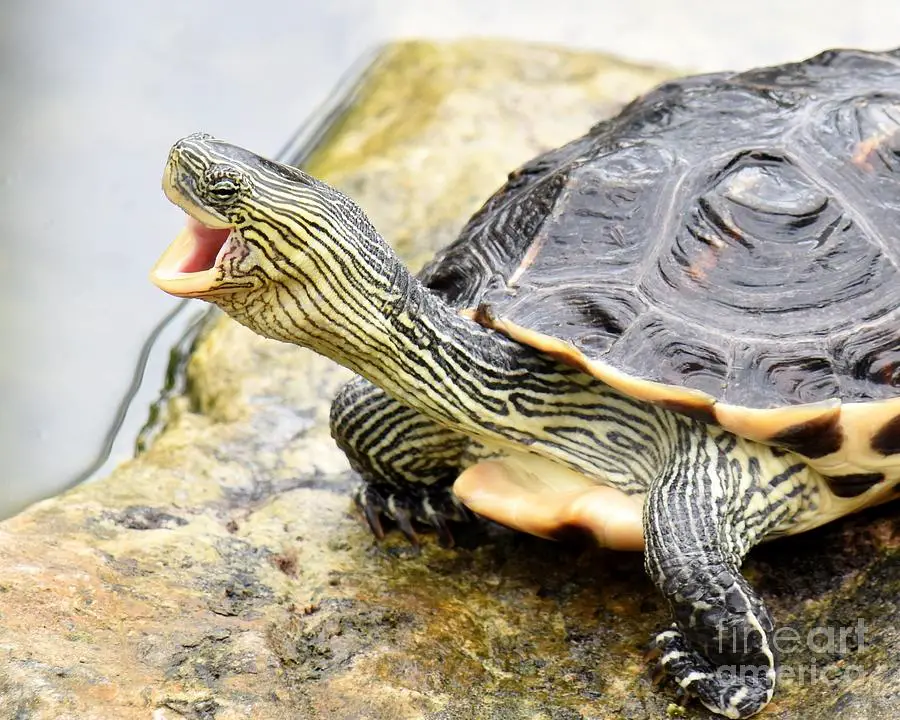
Common Health Problems
Golden Thread Turtles are very hardy and resilient animals that get to live for a very long time because of how healthy these turtles generally are. That said, they are still pretty much vulnerable to a lot of different diseases if you do not take care of them properly or if you do not provide them with the best type of nutrition available for them. Here are some of the common health problems that Golden Thread Turtles face:
Metabolic bone disease
Metabolic bone disease is very common in turtles and other reptiles in general. This is usually the cause of a poor diet as the phosphorous to calcium ratio in their blood may be too high. This disease may lead to deformed limbs, weak shells, fatigue, and general weakness in the turtle’s bones.
Parasites
Internal parasites are pretty common in wild-caught Golden Thread Turtles, but those who live in the wild are often resistant to them. However, the stress-induced by transport and adjustment may weaken the immune system of these turtles and may perhaps allow the internal parasites to propagate. In that sense, you better be careful when choosing your turtles as those caught in the wild are more prone to the effects of internal parasites.
Preventing Illness
Illnesses in Golden Thread Turtles are quite easy to prevent so long as you know the common health problems that plague these reptiles. First off, providing them with food that is nutritious and balanced both in macronutrients and micronutrients is essential. Make sure to feed them with food that that is high in calcium and low in phosphorous to balance out the calcium and phosphorus levels in their blood. Also, it is best to go for captive-bred Golden Thread Turtles because they are less likely to carry internal parasites that wild-caught turtles get in the wild.
Hibernation
During the winter seasons, Golden Thread Turtles may go through a period wherein they are less likely to be active than normal. Some of these turtles may actually hibernate during the cold seasons, but experts believe that this should be avoided. As much as possible, try not to allow your Golden Thread Turtle to hibernate. Keep temperatures up during the colder seasons to prevent them from falling into a hibernated state. Always keep them indoors and in their enclosure during the winter to make sure that they do not hibernate.
Behavior
Golden Thread Turtles are actually very docile animals that will be quite receptive to handling from humans. These turtles are very timid and may somewhat be a bit shy at first. However, as long as you regularly socialize with them and feed them personally, they are quick to become friendly towards you and will recognize you as their owner or their handler. As much as possible, try to socialize with these turtles daily so that they will eventually become more sociable towards you.
As long as you feed them yourself, they are quick to relate you to food and will be very excited to see you. The moment they sense your presence, they will actually swim excitedly towards you, thinking that you have food for them. In that sense, their temperament is perfect for many different types of owners. Some believe that the Golden Threat Turtle is also ideal for beginner owners because of how easy they are to handle.
The Golden Thread Turtle is diurnal and is more likely to be active during the day. In that sense, it is better to socialize with them during the day when they are much more receptive to your handling and your feeding.
Golden Thread Turtles are also fond of being together with other turtles of similar or different species. They may enjoy the company of their Japanese counterparts, but it is still recommended that you keep them away from other turtles of different species because of the possibility of spreading diseases. You can also house them together with small types of fish but, again, that is not recommended because there is a really good chance they will try to eat the fish.
Habitat
In captivity, the Golden Thread Turtle really is not a very demanding reptile. What you really need to focus on whenever you are putting up a habitat for your turtle indoors is to give it a container that is big enough for it. Glass tanks, storage bins, or any other container that can safely contain water without spilling is ideal housing for your Golden Thread Turtle. But, if you want to be able to observe what the turtle is doing, it might be best to go for a container that is see-through such as glass or clear plastic. For the larger females, you may want a container that can hold about a hundred gallons of water. But if you are breeding a male with a female, it is best to house them in a bigger container that can hold 150 gallons of water. Hatchlings and smaller Golden Thread Turtles can be housed in almost any kind of container so long as the water depth is at least an inch and a half deep.
The next thing that should be on your mind is to put up a good basking platform that your turtle can use to emerge from the water and dry itself out completely. Drying itself out completely while basking is essential for the turtle to shed its old skin easier. Some pet owners prefer their tanks to be 85% water and 15% of the land. The 15% land should be where the turtle can safely dry itself out whenever it wants to. You can use gravel or wood for the land portion of the habitat.
Meanwhile, as to the water portion, make sure to fill the bottom of the tank with aquarium gravel. There should also be a water pump and a water filter for sanitation purposes inside the tank and to make sure that the habitat is supplied with fresh and clean water on a regular basis as the dirty water gets filtered out. You can add furnishings to the tank for some added aesthetics.
Lighting and Humidity
The Golden Thread Turtle needs a light source in the tank. You need not go for a really strong light source such as a heat lamp. Instead, what is essential here is an ultraviolet B lamp that will provide the turtle with its needed vitamin D3 to help counteract the phosphorous levels in its blood and to allow it to metabolize calcium better.
As to humidity, since the Golden Thread Turtle spends most of its time underwater and would only go on land to bask and dry itself completely, the humidity level really is not a very big issue as it is more than likely that the tank is humid enough because it is 85% water. That said, what you should focus here is that the tank should have a regular and fresh supply of water so as to make sure that the Golden Thread Turtle does not dry out or feel dehydrated.
Temperature
Golden Thread Turtles are actually very tolerant when it comes to different temperature conditions. Generally, you should try to make sure that the temperatures in the water are about 75 to 80 degrees Fahrenheit. Meanwhile, the air temperature can be a bit hotter and should be right around somewhere between 80 to 85 degrees. In the dry area, the temperature should be at its hottest and should not exceed 90 degrees Fahrenheit.
You can achieve the temperatures in the tank by using a combination of different types of light. The usual source of light and heat is a UVB fluorescent lamp, but the problem here is that these types of light are not really effective at producing heat but are efficient at producing UVB rays. In that case, an additional heat source might be needed. You can use an incandescent bulb in the basking area of the turtle because that is where the tank should be at its hottest. However, you can also use submersible heaters or mercury vapor bulbs in place of the usual UVB and incandescent bulb combination.
Sanitation
Sanitation is essential in keeping your Golden Thread Turtle healthy and thriving. The tank should have a water pump and water filtration system that will automatically clean the water inside the tank while supplying a fresh batch regularly. However, that might not always be enough to make sure that the tank stays clean. You can take the turtle out for a while and move it in a different container to clean and sanitize the entire tank the old-fashioned way. By doing so, you are making sure that the tank stays clean and sanitary while minimizing the risk of any bacteria building up.
Natural Environment – Substrate
Unlike other enclosures or habitats, the Golden Thread Turtle does not require the usual type of substrate that some reptiles tend to need. Instead, the water portion of the tank should be filled with aquarium gravel at the bottom portion. Meanwhile, the land portion can be made out of wood or gravel.
Hydration
Hydration should never be an issue for your Golden Thread Turtle. After all, your turtle primarily lives in water and spends about 90% of its time submerged. That is how it stays moist and hydrate all the time. Sanitation also is not a very big issue here, so long as you have a working and effective water pump and water filter that regularly cleans the water inside the tank.
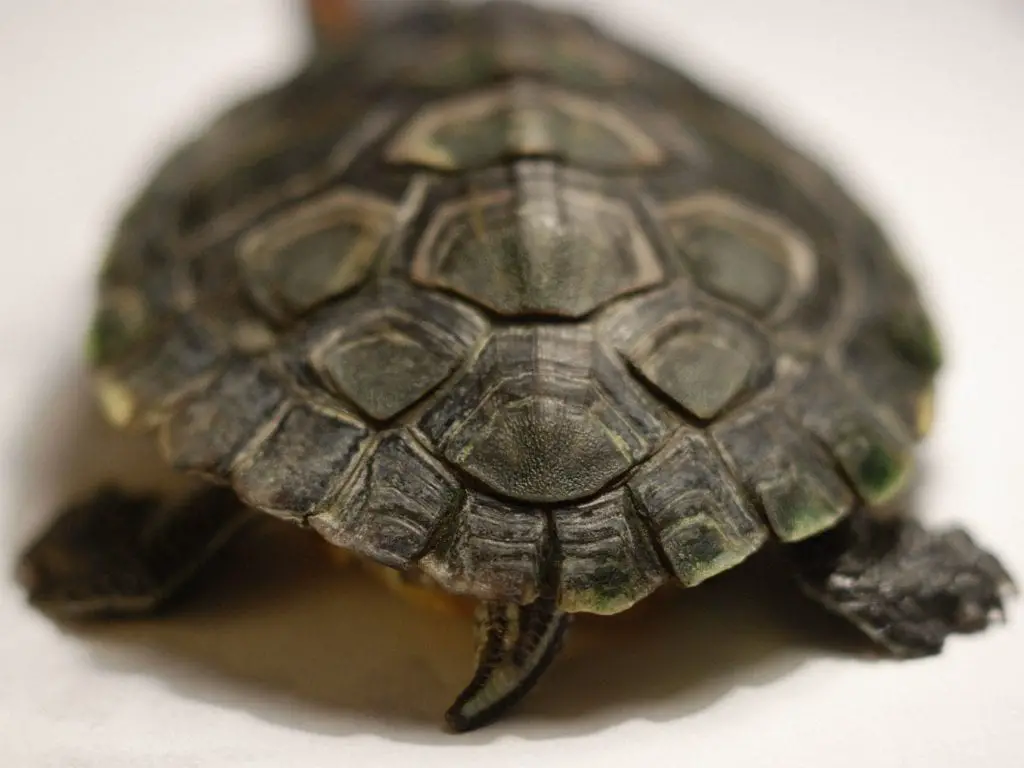
Availability – Where to Get One?
Golden Thread Turtles are very common pets and are quite easy to get your hands on. Unlike other reptiles, which tend to be classified as exotic pets, the Golden Thread Turtle can be found in a lot of pet shops and are not really very expensive at all. If not, you can easily procure one online in many turtle specialty stores. These turtles are not very expensive and are generally somewhere near the $50 price range.
How to Care for a Golden Thread Turtle?
Here are some tips on how to care for a Golden Thread Turtle:
- Golden Thread Turtles are quite submissive to human care as long as you regularly interact and socialize with them and also feed them personally.
- These turtles can be quite shy at first but will grow in confidence as long as they recognize you as their owner or handler.
- Golden Thread Turtles will eat almost anything you offer them and are not very picky eaters. Be careful with what you feed them because they will nibble on almost anything that is edible.
- Known as great pond turtles, the Golden Thread Turtle can live in harmony with fellow turtles of the same species. In some cases, they also do well with other turtles from different species.
- Always make sure that the tank has a basking area where your Golden Thread Turtle can dry itself out completely.
FAQ Section
Do Golden Thread Turtles bite humans?
There are no accounts of Golden Thread Turtles actually biting humans because these are not aggressive animals and are quite docile and submissive to humans handling them.
Are Golden Thread Turtles good for beginner owners?
Golden Thread Turtles are some of the more popular turtles of beginner owners because of how easy they are to take care of and how hardy and resilient these reptiles are.
How long do Golden Thread Turtles get to live?
So long as they are receiving the proper care they need, Golden Thread Turtles will get to live for as long as 40 to 60 years.
How big do Golden Thread Turtles get?
It depends. Female Golden Thread Turtles can be as big as 12 inches while males rarely grow bigger than 8 inches.

